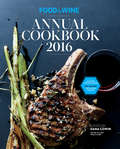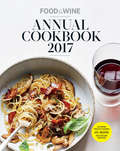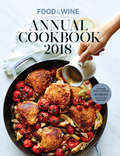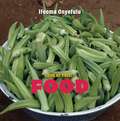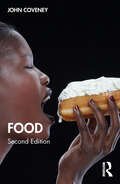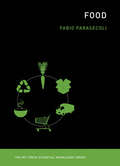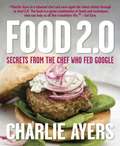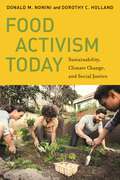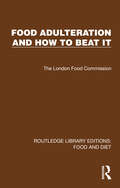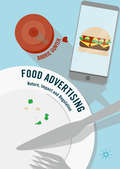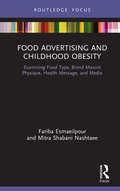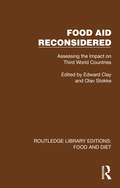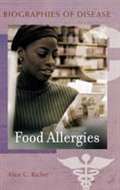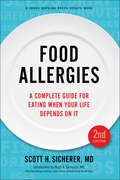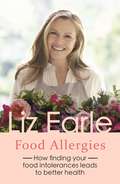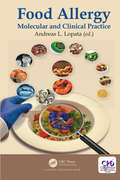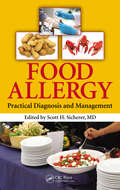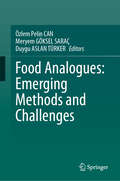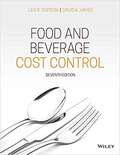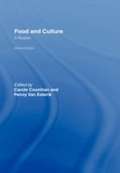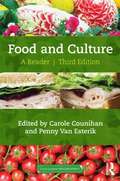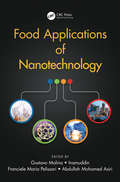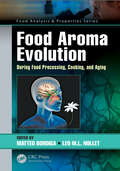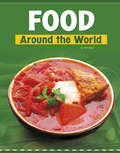- Table View
- List View
Food & Wine Annual Cookbook 2016
by Dana CowinFOOD & WINE's annual cookbook is filled with more than 680 of the year's best recipes from chefs around the world.This expertly curated collection features fabulous dishes, fresh flavors, and new ways to prepare familiar ingredients. Discover creative ideas for every occasion, from weeknight dinners and weekend brunches to cocktail parties and holiday meals.Dishes with global influences and DIY techniques reflect today's taste in food. You'll find recipes for Venezuelan Fresh Corn Cakes with Cheese, Grilled Masala Prawns,Tunisian Chicken Skewers, and Sweet-and-Spicy Spareribs with Korean Barbecue Sauce; instructions for homemade mozzarella and DIY Chinese dumplings; as well as updated takes on classic dishes, such as Pork Milanese with Dandelion Greens Salad and the perfect Caramel Layer Cake. Look out for contributions from some of the biggest names in food, including Mario Batali, Carla Hall, Tyler Florence, and more.Gorgeous color photographs throughout provide endless inspiration, while clear instructions and step-by-step photographs guarantee delicious success.
Food & Wine Annual Cookbook 2017
by Matt MooreFood & Wine's annual cookbook is filled with the year's best recipes from chefs around the world.This expertly curated collection features fabulous dishes, fresh flavors, and new ways to prepare familiar ingredients. Discover creative ideas for every occasion, from weeknight dinners and weekend brunches to cocktail parties and holiday meals.Gorgeous color photographs throughout provide endless inspiration, while clear instructions and step-by-step photographs guarantee delicious success.
Food & Wine Annual Cookbook 2018
by The Editors of Food WineFood & Wine's annual cookbook is filled with the year's meticulously tested recipes from star chefs. This expertly curated collection features simple, fabulous dishes all perfected in our Test Kitchen. Discover creative ideas for every occasion, from weeknight dinners and weekend brunches to cocktail parties and holiday meals.
Food (Look At This!)
by Ifeoma OnyefuluPhotographed in Mali by a multi-award-winning author, this is a unique and culturally diverse word book, with lots to look at and talk about. Mango, rice, plantain, okra...
Food (Shortcuts Ser.)
by John CoveneyIn Food, John Coveney examines ‘food as … ’ identity, politics, industry, regulation, the environment, justice and gastronomy. He explores how food helps us understand what it means to be human. The centrality of food in life, and the importance of food as life, is undeniable. As a source of biological substrates, personal pleasure and political power, food is and has been an enduring requirement of human biological, social and cultural existence. In recent years, interest in food has increased across the academic, public and popular spheres, fuelled by popular media’s constant play on the role of food and body size, and food and cooking, as a mass spectacle for TV audiences. Through food, we construct our social identities, our families and communities. However, Coveney also highlights the tensions between the industrialisation of food, the environment, and the iniquitous distribution of food. He also considers how the food industries, on which most of us must rely, have also had direct effects on our bodies through diet, and the development of illness and diseases. This accessible primer is for students and general readers alike, indeed, for anyone with an interest in food. It questions the idea that food is merely something inert on the plate. Instead, it shows how influential, symbolic, powerful and transformative food has come to be.
Food (The MIT Press Essential Knowledge Series)
by Fabio ParasecoliA consumer's guide to the food system, from local to global: our part as citizens in the interconnected networks, institutions, and organizations that enable our food choices. Everybody eats. We may even consider ourselves experts on the topic, or at least Instagram experts. But are we aware that the shrimp in our freezer may be farmed and frozen in Vietnam, the grapes in our fruit bowl shipped from Chile, and the coffee in our coffee maker grown in Nicaragua, roasted in Germany, and distributed in Canada? Whether we know it or not, every time we shop for food, cook, and eat, we connect ourselves to complex supply networks, institutions, and organizations that enable our food choices. Even locavores may not know the whole story of the produce they buy at the farmers market. In this volume in the MIT Press Essential Knowledge series, food writer and scholar Fabio Parasecoli offers a consumer's guide to the food system, from local to global.Parasecoli describes a system made up of open-ended, shifting, and unstable networks rather than well-defined chains; considers healthy food and the contradictory advice about it consumers receive; discusses food waste and the implications for sustainability; explores food technologies (and “culinary luddism”); and examines hunger and food insecurity in both developing and developed countries. Parasecoli reminds us that we are not only consumers but also citizens, and as citizens we have more power to improve the food system than we do by our individual food choices.
Food 2.0: Secrets From The Chef Who Fed Google
by Karen Alexander Charlie Ayers Carolyn HumphriesIn a cutting edge cookbook for the Internet generation, Google's legendary founding super-chef tells readers what they need to know about the newest nutrition buzzword: brainfood. "Food 2. 0" outlines the basics on how the right foods can transform the mind and body.
Food Activism Today: Sustainability, Climate Change, and Social Justice (Social Transformations in American Anthropology #6)
by Dorothy C. Holland Donald M. NoniniIlluminates how food activism has been taking shape and where it is headedAs climate change, childhood obesity, and food insecurity accelerate at an alarming pace, activists around the country are working to address the pressing need for healthy and sustainable solutions to feed the population. Food Activism Today investigates the new approaches food activists are taking as they formulate alternatives to the current unsustainable agro-industrial food system.Drawing on ethnographic research conducted over an eleven-month period in both urban and rural North Carolina, the volume addresses questions about the moral visions of food activists, how class and racial hierarchies infuse some food activism movements, and how food activism relates to climate change and imminent ecological collapse. Exploring food activism around both local and sustainable food production and food security for lower-income people, the volume finds surprisingly little overlap, with the two movements seemingly remaining distinct approaches (at least for now) to issues around the food system, climate change, and access to healthy food choices.As the US moves into an era in which climate change and neoliberal tensions are conjoined in a looming political crisis, Food Activism Today looks at where food activism is headed, the ethics and issues surrounding alternative approaches to food production, and how food production is related to broader issues of climate change.
Food Adulteration and How to Beat It (Routledge Library Editions: Food and Diet)
by The London Food Commission‘All natural: no artificial colours or flavours’. This was an increasingly familiar claim made for the food we bought in the late 1980s. But what about the other ingredients? Additives are only one form of adulteration. Nitrates, excess water, pesticide residues, too much fat, and the newest of them all food irradiation, are some of the others. The questions they pose for all of us are inescapable, as is the overall issue of poor-quality food dressed up to be what it is not.In this book, originally published in 1988, the London Food Commission, Britain’s independent food watchdog, spells out the dangers, and suggests solutions. It challenges official policy and condemns official secrecy. It says why British food is the sick food of Europe. It believes that what is needed is a major shake-up in Whitehall and the food trades, and calls for a new anti-adulteration alliance – a positive campaign for improved food policy. And it backs all arguments with rigorous and detailed evidence.Food matters to everyone. We deserve the best. We will only get it if we demand it. This book spelt out what our demands should be. Still a big topic of interest today this is an opportunity to look at some early issues surrounding the food we buy and assess how far we’ve come.
Food Advertising
by Barrie GunterThis book provides an up-to-date and comprehensive review and critique of the scientific evidence concerning the prevalence, nature and potential effects of food advertising and other forms of marketing on children. There is growing international concern about the prevalence of childhood obesity and associated health problems. Poor quality diet and nutrition has been blamed. The food and soft drinks industries have been targeted in this context for their promotions of foods and drinks that are high in salt, sugar and fat content. Many of the most widely promoted and consumed food brands fail to meet recommended nutritional standards. What is the evidence for the effects of food promotions on children's food preferences, diets and health? This book draws on evidence from around the world, reviewing the major studies before presenting a fresh assessment of the state of play. It considers also the issue of food regulation and advertising codes of practices, the need for better and relevant consumer education and socialisation about advertising and nutrition.
Food Advertising and Childhood Obesity: Examining Food Type, Brand Mascot Physique, Health Message, and Media (Routledge Studies in Marketing)
by Fariba Esmaeilpour Mitra Shabani NashtaeeThis book explores the ways in which the environmental factor of advertising can influence children’s food choice and health status, and how it contributes to the significant public health issue of childhood obesity. Food Advertising and Childhood Obesity seeks to gain a better understanding of children’s food choice based on children’s exposure to different advertising by analyzing food type, brand mascot physique, health messages, and media. The book begins by reviewing the ways in which children become consumers and the role of advertising in this process. It then explores a range of advertising variables in children’s food choice and consumption. This includes theoretical and practical discussion of foods and brand mascots, health messages embodied in food advertising, and comparisons of the effects of different advertising based on entertainment level, such as using new media to present ‘advergames’ supported by television advertising. Each chapter is supported with relevant theories and a research summary is presented on each topic for clarification. The book also introduces some ways of constructive working with children and concludes with a chapter dedicated to market research and children. Written for students and practitioners of marketing, market research, and advertising, especially within the global food industry, this book offers readers a new approach to understanding child food choice and consumption that will inform effective corporate social responsibility strategies to address this issue.
Food Aid Reconsidered: Assessing the Impact on Third World Countries (Routledge Library Editions: Food and Diet)
by Olav Stokke Edward ClayFood aid continues to be a high profile, and perhaps the most controversial form of aid. Food Aid Reconsidered: Assessing the Impact on Third World Countries, originally published in 1991, which concentrates on recent experience, especially in Sub-Saharan Africa, provided a stocktaking on the state of the debate and the contribution that economics and other social sciences had made to resolving many of the controversies surrounding food aid at the time. These issues include the gap between the potential and actual contribution of food aid on food security and agricultural production in developing countries, European dairy aid to India and possible alternatives to exporting food from developed countries for providing humanitarian assistance to hungry people. Today it can be read in its historical context.
Food Allergies (Biographies of Disease)
by Alice C. RicherMost people take eating for granted - but for some, eating can be downright dangerous. Thirty thousand Americans are hospitalized each year due to an allergic food reaction and peanut allergies in American children doubled from 1997 to 2002.
Food Allergies: A Complete Guide for Eating When Your Life Depends on It (A Johns Hopkins Press Health Book)
by Scott H. SichererThe essential guide for anyone who suffers from food allergies.Posing the urgent questions that anyone with food allergies will think to ask—and then some—Food Allergies provides practical, sensitive, and scientific guidance on the topics that affect your life. Allergy expert Scott H. Sicherer addresses the full spectrum of food allergies, from mild to life threatening and from single foods to food families, clearing up misconceptions along the way. He explores how exposure to foods can bring about an allergic response, describes the symptoms of food allergy, and illuminates how food allergies develop.Organized in an accessible Q&A format and illustrated with case studies, the book thoroughly explains how to prevent exposure to a known allergen at home, at school, in restaurants, and elsewhere. Dr. Sicherer also gives valuable advice about what to do if exposure occurs, including how to handle an anaphylactic emergency. Finally, he describes tests for diagnosing food allergies and chronic health problems caused by food allergies, such as eczema, hives, and respiratory and gastrointestinal symptoms.In this thoroughly updated new edition, Dr. Sicherer• describes new approaches to prevent food allergies• presents cutting-edge theories on risk factors for developing food allergies• describes innovative allergy tests to improve diagnosis• explains how to administer emergency medications for severe reactions• focuses on new allergens of concern, such as pink peppercorns• analyzes studies suggesting that resolution of an allergy might be predictable• talks about the role of "healthy diet"• lists additional resources, including allergy-related apps• provides revised school food allergy guidelines• offers insights into food allergy bullying—and advice to reduce itDr. Sicherer also reviews food reactions that are not allergic (such as lactose intolerance and celiac disease), advises how to get adequate nutrition when you must avoid dietary staples, and discusses whether allergies ever go away (they do—and sometimes they return).
Food Allergies: How finding your food intolerances leads to better health (Wellbeing Quick Guides)
by Liz EarleLiz Earle explains why your body may be responding badly to some foods and helps you to find out which foods should be avoided to make you feel more energetic, slim and healthy.Bestselling beauty and wellbeing writer Liz Earle's fully revised and updated quick guide to food allergies, including:- An introduction to causes and types of allergies and intolerances- A guide to the most common food allergens and how to prevent them- Advice on how to detect if you have a food sensitivity- How to conduct an exclusion diet at home- Tips on preventing and detecting allergies in children
Food Allergy Advocacy: Parenting and the Politics of Care
by Danya GlabauA detailed exploration of parents&’ fight for a safe environment for their kids, interrogating how race, class, and gender shape health advocacy The success of food allergy activism in highlighting the dangers of foodborne allergens shows how illness communities can effectively advocate for the needs of their members. In Food Allergy Advocacy, Danya Glabau follows parents and activists as they fight for allergen-free environments, accurate labeling, the fair application of disability law, and access to life-saving medications for food-allergic children in the United States. At the same time, she shows how this activism also reproduces the culturally dominant politics of personhood and responsibility, based on an idealized version of the American family, centered around white, middle-class, and heteronormative motherhood.By holding up the threat of food allergens to the white nuclear family to galvanize political and scientific action, Glabau shows, the movement excludes many, including Black women and disabled adults, whose families and health have too often been marginalized from public health and social safety net programs. Further, its strategies are founded on the assumption that market-based solutions will address issues of social exclusion and equal access to healthcare. Sharing the personal experiences of a wide spectrum of people, including parents, support group leaders, physicians, entrepreneurs, and scientists, Food Allergy Advocacy raises important questions about who controls illness activism. Using critical, intersectional feminism to interrogate how race, class, and gender shape activist priorities and platforms, it shows the way to new, justice-focused models of advocacy.
Food Allergy: Molecular and Clinical Practice
by Andreas L. LopataFood allergy is an adverse immunological reaction to allergens present in food. Up to 4% adults and 8% children are affected by food allergy. The increase in allergic diseases to food has led to the need for better diagnostics and more effective therapeutic approaches. This book describes the molecular biology and immunology of major food allergens, from laboratory based science to clinical immunology, encompassing novel characterisation and quantification methods, the application of recombinant food allergens in molecular diagnosis and the development of novel therapeutics. This book is the ideal reference tool for researchers, students and allergy clinicians to accurately diagnose and manage food allergies.
Food Allergy: Practical Diagnosis and Management
by Scott H. SichererFood allergy has increased over the past two decades, with a larger number of patients presenting a myriad of related symptoms and illnesses to physicians and allied health professionals. The growing number of patients poses a challenge to health care providers and confirms the need for developing best clinical practice guidelines. Based on the Exp
Food Analogues: Emerging Methods and Challenges
by Özlem Pelin Can Meryem Göksel Saraç Duygu Aslan TürkerAs vegetarian and vegan diets have taken hold across the Western world in recent years, the food industry has in turn seen a burgeoning demand for plant-based substitutes, known as analogues. Consumers are hungry for a product that aligns with their values, meets their nutritional needs, and also delivers on its promise of simulating the qualities of its target food item, be that beef, chicken, egg or dairy. Researchers are thus continually working to more closely approximate not only the taste but also the aesthetic, textural and rheological properties of the food item they are imitating. Meanwhile, questions about the nutritional content and environmental impact of food analogues are also of major interest for conscious consumers. While existing volumes have covered specific analogues such as meat or dairy, Food Analogues: Emerging Methods and Challenges will be the first to offer an authoritative overview of all food analogues and comprehensively assess the current and future state of the industry. This text covers both the fundamental processes of textural manipulation and sensory evaluation as well as the microbiological and regulatory aspects of these plant-based substitutes. Looking towards the future of food analogue technology, it will also discuss promising new approaches such as the use of 3D printing and edible insects in analogue production. This book will be of value to researchers, manufacturers, regulators, nutritionists, and even consumers themselves, seeking to make more informed decisions about their diets.
Food And Beverage Cost Control
by David K. Hayes Lea R. DopsonProfessional foodservice managers are faced with a wide array of challenges on a daily basis. Controlling costs, setting budgets, and pricing goods are essential for success in any hospitality or culinary business. Food and Beverage Cost Control provides the tools required to maintain sales and cost histories, develop systems for monitoring current activities, and forecast future costs. This detailed yet reader-friendly guide helps students and professionals alike understand and apply practical techniques to effectively manage food and beverage costs. <P><P> Now in its seventh edition, this extensively revised and updated book examines the entire cycle of cost control, including purchasing, production, sales analysis, product costing, food cost formulas, and much more. Each chapter presents complex ideas in a clear, easy-to-understand style. Micro-case studies present students with real-world scenarios and problems, while step-by-step numerical examples highlight the arithmetic necessary to understand cost control-related concepts. Covering everything from food sanitation to service methods, this practical guide helps readers enhance their knowledge of the hospitality management industry and increase their professional self-confidence.
Food And Culture: A Reader
by Carole Counihan Penny Van EsterikFood and Culture: A Reader , is a solidly established classroom and reference text for scholars and students across the humanities and social sciences. It has been assigned in courses in anthropology, cultural studies, folklore, food studies, history, literature, philosophy, sociology, archeology, American studies, and more. Food and Culture remains significant because it demonstrates the centrality of cultural anthropology to the study of food. It is unique in providing an interdisciplinary collection of classic and cutting-edge articles in the field of food and culture studies that combine theory with ethnographic and historical data.
Food And Culture: A Reader
by Carole Counihan Penny Van Esterik<P><P>The classic book that helped to define and legitimize the field of food and culture studies is now available, with major revisions, in a specially affordable e-book version (978-0-203-07975-1). <P><P> The third edition includes 40 original essays and reprints of previously published classics under 5 Sections: FOUNDATIONS, HEGEMONY AND DIFFERENCE, CONSUMPTION AND EMBODIMENT, FOOD AND GLOBALIZATION, and CHALLENGING, CONTESTING, AND TRANSFORMING THE FOOD SYSTEM. <P><P> 17 of the 40 articles included are either, new to this edition, rewritten by their original authors, or edited by Counihan and van Esterik. <P><P> A bank of test items applicable to each article in the book is available to instructors interested in selecting this edition for course use. Simply send an e.mail to the publisher at companionaccess@informa.com.
Food Applications of Nanotechnology
by Gustavo Molina Inamuddin Franciele Maria Pelissari Abdullah Mohamed AsiriNanotechnology has developed remarkably in recent years and, applied in the food industry, has allowed new industrial advances, the improvement of conventional technologies, and the commercialization of products with new features and functionalities. This progress offers the potential to increase productivity for producers, food security for consumers and economic growth for industries. Food Applications of Nanotechnology presents the main advances of nanotechnology for food industry development. The fundamental concepts of the technique are presented, followed by examples of application in several sectors, such as the enhancement of flavor, color and sensory characteristics; the description of the general concepts of nano-supplements, antimicrobial nanoparticles and other active compounds into food; and developments in the field of packaging, among others. In addition, this work updates readers on the industrial development and the main regulatory aspects for the safety and commercialization of nanofoods. Features: Provides a general overview of nanotechnology in the food industry Discusses the current status of the production and use of nanomaterials as food additives Covers the technological developments in the areas of flavor, color and sensory characteristics of food and food additives Reviews nanosupplements and how they provide improvements in nutritional functionality Explains the antibacterial properties of nanoparticles for food applications This book will serve food scientists and technologists, food engineers, chemists and innovators working in food or ingredient research and new product development. Gustavo Molina is associate professor at the UFVJM (Diamantina—Brazil) in Food Engineering and head of the Laboratory of Food Biotechnology and conducts scientific and technical research. His research interests are focused on industrial biotechnology. Dr. Inamuddin is currently working as assistant professor in the chemistry department of Faculty of Science, King Abdulaziz University, Jeddah, Saudi Arabia. He is also a permanent faculty member (assistant professor) at the Department of Applied Chemistry, Aligarh Muslim University, Aligarh, India. He has extensive research experience in multidisciplinary fields of analytical chemistry, materials chemistry, and electrochemistry and, more specifically, renewable energy and environment. Prof. Abdullah M. Asiri is professor of organic photochemistry and has been the head of the chemistry department at King Abdulaziz University since October 2009, as well as the director of the Center of Excellence for Advanced Materials Research (CEAMR) since 2010. His research interest covers color chemistry, synthesis of novel photochromic and thermochromic systems, synthesis of novel coloring matters and dyeing of textiles, materials chemistry, nanochemistry and nanotechnology, polymers, and plastics. Franciele Maria Pelissari graduated in Food Engineering; earned her master’s degree (2009) at the University of Londrina (UEL), Londrina, Brazil; and her PhD (2013) at the University of Campinas (Unicamp), Campinas, Brazil. Since 2013, she has been associate professor at the Institute of Science and Technology program at the Federal University of Jequitinhonha and Mucuri (UFVJM), Diamantina, Brazil, in Food Engineering, and also full professor in the graduate program in Food Science and Technology.
Food Aroma Evolution: During Food Processing, Cooking, and Aging (Food Analysis & Properties)
by Matteo Bordiga, Leo M.L. NolletOf the five senses, smell is the most direct and food aromas are the key drivers of our flavor experience. They are crucial for the synergy of food and drinks. Up to 80% of what we call taste is actually aroma. Food Aroma Evolution: During Food Processing, Cooking, and Aging focuses on the description of the aroma evolution in several food matrices. Not only cooking, but also processing (such as fermentation) and aging are responsible for food aroma evolution. A comprehensive evaluation of foods requires that analytical techniques keep pace with the available technology. As a result, a major objective in the chemistry of food aroma is concerned with the application and continual development of analytical methods. This particularly important aspect is discussed in depth in a dedicated section of the book. Features Covers aromatic evolution of food as it is affected by treatment Focuses on food processing, cooking, and aging Describes both classic and new analytical techniques Explains how the flavor perception results are influenced by other food constituents The book comprises a good mix of referenced research with practical applications, also reporting case studies of these various applications of novel technologies. This text represents a comprehensive reference book for students, educators, researchers, food processors, and food industry personnel providing an up-to-date insight. The range of techniques and materials covered provides engineers and scientists working in the food industry with a valuable resource for their work. Also available in the Food Analysis & Properties Series: Ambient Mass Spectroscopy Techniques in Food and the Environment, edited by Leo M.L. Nollet and Basil K. Munjanja (ISBN: 9781138505568) Hyperspectral Imaging Analysis and Applications for Food Quality, edited by N.C. Basantia, Leo M.L. Nollet, and Mohammed Kamruzzaman (ISBN: 9781138630796) Fingerprinting Techniques in Food Authentication and Traceability, edited by Khwaja Salahuddin Siddiqi and Leo M.L. Nollet (ISBN: 9781138197671) For a complete list of books in this series, please visit our website at: www.crcpress.com/Food-Analysis--Properties/book-series/CRCFOODANPRO
Food Around the World (Customs Around the World)
by Wil MaraTime to eat! Your meal might be sweet or salty. It might have lots of meat or lots of vegetables. Discover what foods people around the world enjoy in this engaging series that develops kids' understanding of our diverse global community and their place in it.
